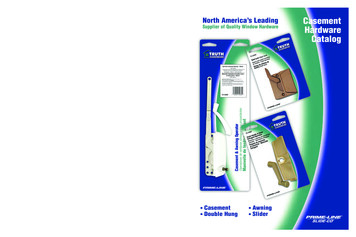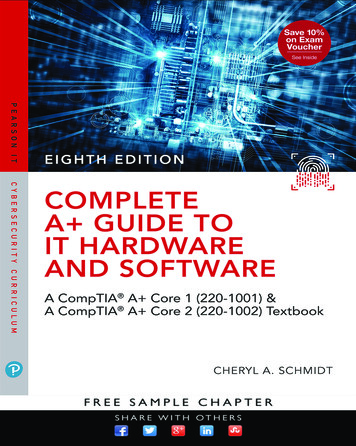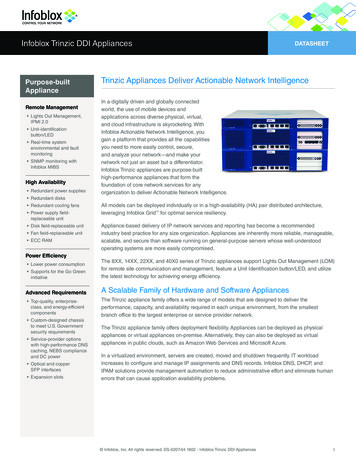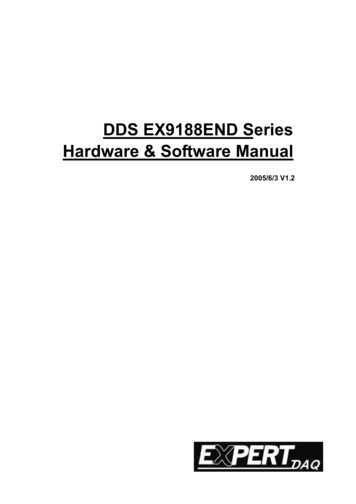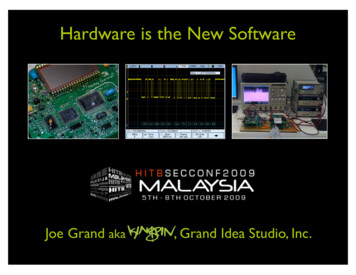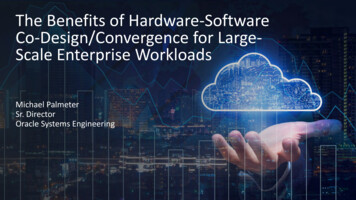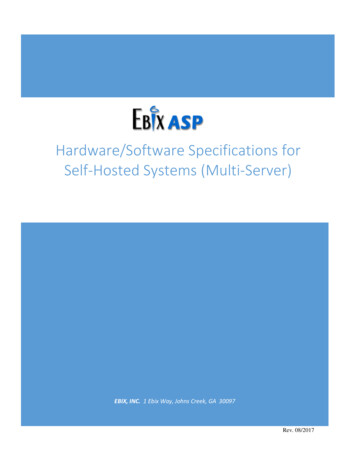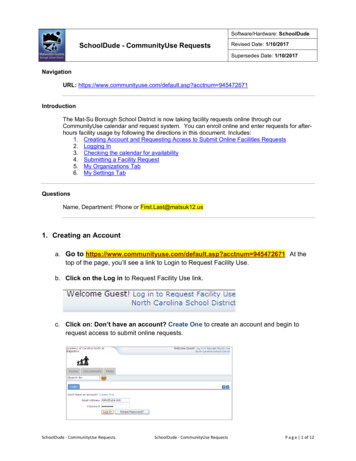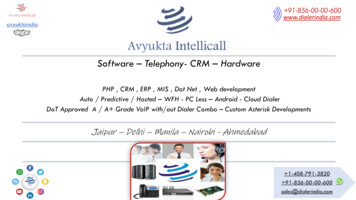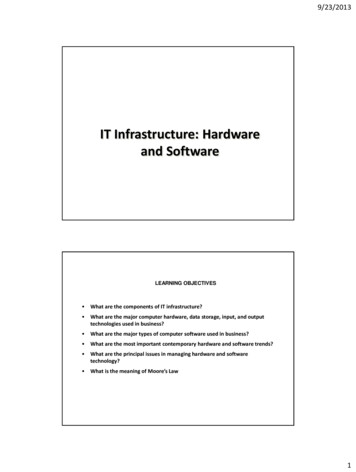
Transcription
9/23/2013IT Infrastructure: Hardwareand SoftwareLEARNING OBJECTIVES What are the components of IT infrastructure? What are the major computer hardware, data storage, input, and outputtechnologies used in business? What are the major types of computer software used in business? What are the most important contemporary hardware and software trends? What are the principal issues in managing hardware and softwaretechnology? What is the meaning of Moore’s Law1
9/23/2013IT Infrastructure: Computer HardwareInfrastructure Components IT infrastructure: provides platform for supporting all information systems in thebusiness Computer hardware Computer software Data management technology Organizes, manages, and processes business data concerned withinventory, customers, and vendors Networking and telecommunications technology Technology services E.g., consultants for systems integration with legacy systemsIT Infrastructure: Computer HardwareIT Infrastructure ComponentsA firm’s IT infrastructure iscomposed of hardware,software, data managementtechnology, networkingtechnology, and technologyservices.Figure 4-12
9/23/2013Moore’s Law Moore’s Law predicts that the number oftransistors fitting on a computer chip will doubleevery one and a half to two years. This prediction about density also capturesadvances in processing speed, storagecapabilities, cost, and other component features. Processing power and speed and storagecapabilities have increased exponentially as thecost of computing devices has decreased. IT Infrastructure: Computer HardwareTypes of Computers Computers come in different sizes with varying capabilities for processinginformation. FLOPS (Floating point operations per second) Smartphones, netbooks, e-book readers Today’s smartphones are far more powerful than the early PCs ofthe 1980s PCs Workstations More powerful mathematical and graphics-processing capabilitiesthan a PC Used primarily for advanced design or engineering work requiringpowerful graphics or computational capabilities.3
9/23/2013IT Infrastructure: Computer HardwareTypes of Computers Servers: Type of midrange computer. Support computer network, sharing files and resources. Provide hardware platform for e-commerce. Mainframes: Large-capacity, high-performance computer that can process largeamounts of data very rapidly E.g., used by airlines for thousands of reservations per second Mainframes are still a major revenue and profit source for IBM, oneof the last large-scale commercial manufacturers of mainframecomputers. They are used often as huge Web servers where they aremore efficient than tens of thousands of PCs in processing largevolumes of recordsIT Infrastructure: Computer HardwareTypes of Computers Supercomputer: More sophisticated computer used for tasks requiring extremelyrapid and complex calculations with thousands of variables, millionsof measurements Used in engineering, scientific simulations, military/weaponsresearch, weather forecasting Grid computing: Video Power of geographically remote computers connected into singlenetwork to act as “virtual supercomputer”4
9/23/2013IT Infrastructure: Computer HardwareTypes of Computers Client/server computing: Form of distributed computing Splits processing between “clients” and “servers” Clients: user point of entry The user generally interacts directly only with the client portionof the application, often to input data or retrieve data forfurther analysis. Servers: store and process shared data and perform networkmanagement activitiesIT Infrastructure: Computer HardwareClient/Server ComputingIn client/servercomputing,computerprocessing issplit betweenclient machinesand servermachines linkedby a network.Users interfacewith the clientmachines.Figure 4-25
9/23/2013IT Infrastructure: Computer HardwareStorage, Input, and Output Technology Primary secondary storage technologies Magnetic disk: Hard drives, USB flash drives RAID: can package hundreds of drives for massive storagerequirements Optical disks CD-ROM, CD-RW, DVD Magnetic tape Storage networking: SANs Connect multiple storage devices on a separate high-speed networkdedicated to storageIT Infrastructure: Computer HardwareA Storage Area Network (SAN)SANs are an effort by corporations to reducestorage costs, manage information, increaseflexibility, and provide near-certain backup.One of the major worries of business firms islosing customer or other digital data.Extraordinary efforts are taken to makeredundant copies of digital information, andplacing it on separate secure servers, evenremote servers in separate facilities.A typical SAN consists of a server,storage devices, and networkingdevices, and is used strictly forstorage. The SAN stores data onmany different types of storagedevices, providing data to theenterprise. The SAN supportscommunication between any serverand the storage unit as well asbetween different storage devices inthe network.6
9/23/2013IT Infrastructure: Computer HardwareStorage, Input, and Output Technology Input devices: Gather data and convert them into electronic form. Keyboard Computer mouse Touch screen Optical character recognition Magnetic ink character recognition Pen-based input Digital scanner Audio input SensorsIT Infrastructure: Computer HardwareStorage, Input, and Output Technology Output devices: Display data after they have been processed. Monitor Printer Audio output Information systems collect and process information in one of two ways. Batch processing: transactions stored for predefined amount oftime, then processed as group Online processing: transactions processed immediately7
9/23/2013IT Infrastructure: Computer HardwareContemporary Hardware Trends The emerging mobile digital platform Based on new handheld hardware like cell phones, netbooks, andtablet computers. A new “platform.” Wireless communications through 3G cell networks and Wi-Fi. New software apps. Nanotechnology: video Uses individual atoms and molecules to create computer chips andother devices that are thousands of times smaller than currenttechnologies permit. Nanotechnology shrinks the size of transistors down to the width ofseveral atoms.IT Infrastructure: Computer HardwareExamples of NanotubesNanotubes are tinytubes about 10,000times thinner than ahuman hair. Theyconsist of rolled upsheets of carbonhexagons, havepotential uses asminuscule wires or inultrasmall electronicdevices, and are verypowerful conductors ofelectrical current.Figure 4-58
9/23/2013IT Infrastructure: Computer HardwareContemporary Hardware Trends Cloud Computing: video A model of computing in which firms and individuals obtain computingresources over the Internet Cloud infrastructure as a service customers use processing, storage, networking, and othercomputing resources from cloud service providers to run theirinformation systems. Cloud platform as a service customers use infrastructure and programming tools hosted bythe service provider to develop their own applications. Cloud software as a service customers use software hosted by the vendor. Top Free Cloud Computing SoftwareCloud Advantages Eliminates need for large up-front capital investments in systems Eliminates lengthy implementations on corporate computers Low cost subscriptions; no expensive licensing and maintenancefees No hardware for subscribers to purchase, scale, and maintain No operating systems, database servers or applications servers toinstall No consultants and staff Accessible via standard Web browser with behind-the-scenesoftware updates Better scalability, eliminate cost and complexity of managingmultiple layers of hardware and software9
9/23/2013Cloud Disadvantages May not be attractive to larger companies fortheir application needs Responsibility of data storage and control is in thehands of the provider Security risks may increase and openvulnerabilities to data maintenance System reliability issues Users dependency on the cloud computingproviderIT Infrastructure: Computer SoftwareCloud Computing PlatformIn cloud computing, hardware and software capabilities are provided as services over the Internet. Businesses and employees have access toapplications and IT infrastructure anywhere at any time using an Internet-connected device.Figure 4-610
9/23/2013Virtualization Autonomic computing: Development of systems that can configurethemselves, heal themselves; e.g., self-updatingantivirus softwareIT Infrastructure: Computer HardwareContemporary Hardware Trends Virtualization: video Process of presenting a set of computing resources so they can beaccessed in ways that are unrestricted by physical configuration orgeographic location IBM’s mainframes run tens of thousands of separate instances ofWindows or Linux on a single large mainframe computer, giving usersthe impression they have their own dedicated computer Server virtualization: running more than one operating system at thesame time on single machine. Virtual memory is memory which fools the processor into thinking itis hardware memory but in fact is memory located on a hard drive.11
9/23/2013IT Infrastructure: Computer HardwareContemporary Hardware Trends Multicore processors: Integrated circuit with two or more processors Enhanced performance, reduced power consumption, and moreefficient simultaneous processing of multiple tasksIT Infrastructure: Computer SoftwareOperating System Software The software that manages and controls the computer’s activities PC operating systems and graphical user interfaces GUIs Windows XP, Windows Vista, and Windows Server 2003 UNIX Linux Open-source software12
9/23/2013IT Infrastructure: Computer SoftwareThe Major Types of SoftwareThe relationship among thesystem software, applicationsoftware, and users can beillustrated by a series of nestedboxes. System software—consisting of operating systems,language translators, and utilityprograms—controls access to thehardware. Application software,including programminglanguages and “fourthgeneration” languages, mustwork through the system softwareto operate. The user interactsprimarily with the applicationsoftware.Figure 4-7IT Infrastructure: Computer SoftwareSoftware for the Web: Java, AJAX, and HTML Java: Operating system-independent, processor-independent,object-oriented programming language AJAX: Allows a client and server to exchange data behind thescenes to avoid reloading a Web page after each change Hypertext markup language (HTML): Page description language for specifying how elements areplaced on a Web page and for creating links to other pagesand objects13
9/23/2013IT Infrastructure: Computer SoftwareWeb 2.0 VideoWeb services: Software components that exchange information with one another usinguniversal Web communication standards and languages It’s a “messaging system” which allows diverse computing applications in a firm tocommunicate data with one another without extensive integration of theconstituent applications (which tends to be very expensive) XML (extensible markup language) SOAP (simple object access protocol) WSDL (Web services description language) UDDI (universal description, discovery, and integration) Service oriented architecture (SOA) In a service-oriented architecture, various applications provide “services”(data) on request to other applications needing data. SOA is a major alternative to installing large scale enterprise systems.IT Infrastructure: Computer SoftwareHow Dollar Rent-A-Car Uses Web ServicesDollar Rent-A-Car uses Webservices to provide astandard intermediate layerof software to “talk” toother companies’information systems. DollarRent-A-Car can use this setof Web services to link toother companies’information systemswithout having to build aseparate link to each firm’ssystems.Figure 4-914
9/23/2013IT Infrastructure: Computer SoftwareSoftware Trends Open Source Software Linux, Apache Cloud Computing Google Apps, Office Web AppsMashups are Web applications that combine content or data from multipleonline sources into new Web applications Contents are continually updated Content for mashups often comes from Web feeds and Web services Amazon uses mashup technologies to aggregate product descriptionswith partner sites and user profiles, commentaries, and images. Travel sites, such as Travelocity, Kayak, Matador, and Travature, integratestandard content (such as airfare search engines, travel guides, maps,and hotel reviews) with comments, ratings, and images from users. Software as a Service (SaaS) Salesforce.comManaging Hardware and Software Technology Capacity planning Process of predicting when hardware system becomes saturated Ensuring firm has enough computing power for current and future needs Factors include: Maximum number of users Impact of current, future software Performance measures minimum response time for processing business transactions. Throughput Scalability: ability of system to expand to serve large number of users withoutbreaking down Organizations must ensure they have sufficient computer processing, storage, andnetwork resources to handle surging volumes of digital transactions and to makesuch data immediately available online.15
9/23/2013Managing Hardware and Software Technology Total Cost of Ownership (TCO) model Used to analyze direct and indirect costs to help determine the actualcost of owning a specific technology Direct costs: hardware, software purchase costs Indirect costs: ongoing administration costs, upgrades, maintenance,technical support, training, utility, and real estate costs Hidden costs: support staff, downtime, additional networkmanagementFive year TCO for computing equipment can be 3 – 10 times the originalpurchase price TCO can be reduced through increased centralization, standardizationof hardware and software resources.Components of TCO for a IT SystemHardware acquisitionPurchase price of hardware including computers, terminals, storage and printersSoftware acquisitionPurchase or license of software for each userInstallationCost to install hardware and softwareTrainingCost to train IT staff and end-usersSupportCost to provide ongoing technical support; help desks, documentation etcInfrastructureCost to acquire, maintain and support related infrastructure such as networks andspecialized equipment (including storage and backup units)DowntimeLost productivity if hardware or software failures cause the system to unavailable forprocessing user tasksSpace and energyReal estate and utility costs for hosing and providing power for the technology16
9/23/2013Strategies for Creating and Deploying Software Commercial off-the-shelf software solutions areready-made and available for licensing or sale to thegeneral public– Off-the-shelf software systems that cannot be modified tomeet the specific needs of a particular organization aresometimes called turn-key systems or software Custom software development describes how anorganization develops and builds software tailoredspecifically to its needs.Strategies for Creating and Deploying Software continued Using technology service providers Outsourcing Using external provider to: Run networks. Host, manage Web site(s). Develop software (offshore software outsourcing). Manage IT infrastructures. Requires Service Level Agreements (SLAs) a formal contracts between customers and serviceproviders that define the specific responsibilities ofthe service provider and the level of service expectedby the customer.17
9/23/2013Advantages of Outsourcing Allows a business to concentrate on its core competencies ratherthan focusing on technology issues. Instead of purchasing all the necessary hardware and software forhosting a Web site, a business can use a Web hosting service thatmaintains a large Web server Outsourcing custom software development or maintenance tooutside firms benefits a company because it won’t have to hireprogrammers, analysts, and managers with the necessary skills. An outsourcer often has the technical and management skills to dothe job better, faster, and more efficiently. Even though it’s often cheaper to outsource the maintenance of anIT infrastructure and the development of new systems to externalvendors, a business must weight the pros and cons carefully.Managing Hardware and Software Technology Using cloud services Small businesses “rent” infrastructure from another firm to avoidexpenses of maintaining hardware and software on their own. Off-loading peak demand to remote data centers Amazon Markets http://www.amazonservices.com/ Amazon provides cloud services to major business firms, and also tothousands of small merchants who want to use Amazon software tosell their goods and services. Managing mobile platforms Balancing gains in productivity from using mobile devices with expenses ofequipping employees with these devices TCO for wireless devices ranges from 1,000 to 3,00018
9/23/2013Managing Hardware and Software Technology Managing software localization for globalbusiness Local language interfaces English not typically standard at middle, lower levels Interfaces are complex: menu bars, error messages, onlineforms, search results, and so on Differences in local cultures Differences in monetary structure Differences in business processes All of these factors add to TCO of using technology service providers http://www.ricintl.com Language Scientificfirms are translating their systems and localizing them (which is more thanjust translation).19
computing resources from cloud service providers to run their information systems. Cloud platform as a service customers use infrastructure and programming tools hosted by the service provider to develop their own applications. Cloud software as a service customers use software hosted by the ve

